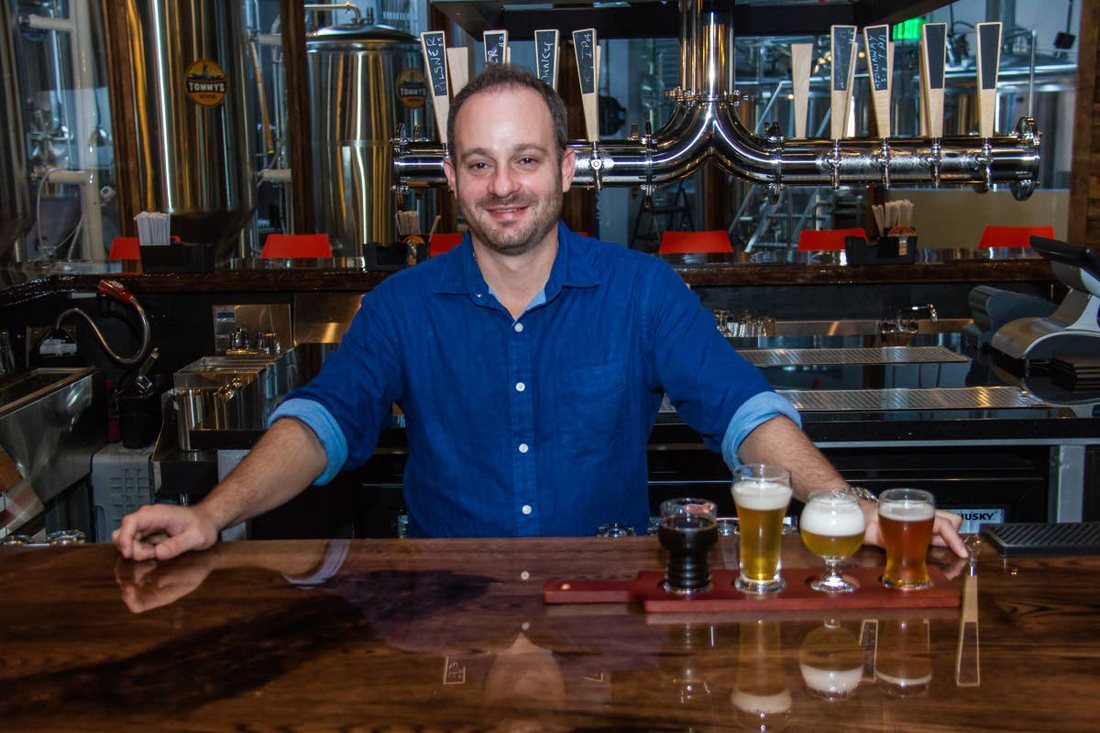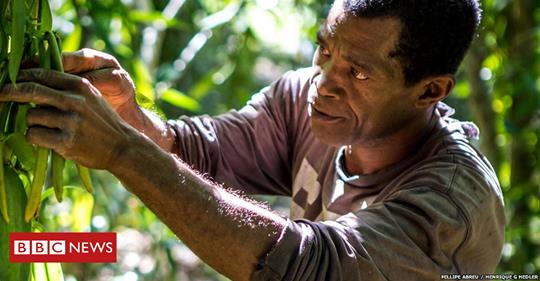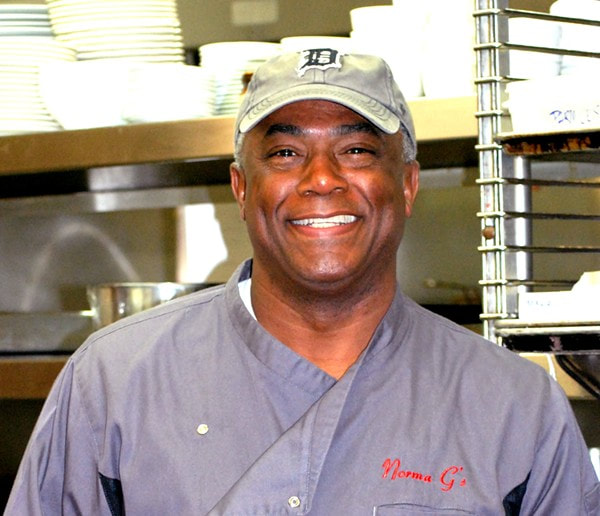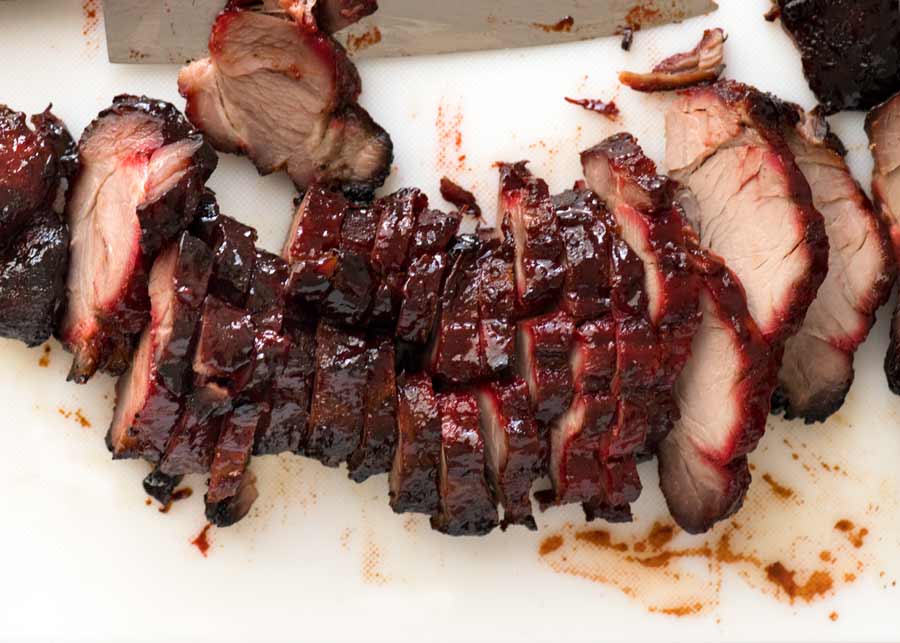|
Trinidadian Fallon Seymour is serving up Trini and Caribbean flavours at Pearl’s Caribbean, a colourful, cozy restaurant located in Williamsburg, Brooklyn.
Here, you’re sure to get all of the foods you’re accustomed to back home in the Caribbean like bake and shark, crab and dumplin’, shrimp roti and jerk chicken. The authentic Caribbean restaurant has been cast into the spotlight after being recently featured on a food segment, Food Adventure, which aired on American cable news television channel NY1. Seymour named the restaurant after her grandmother, Pearl, whom she fondly referred to as “Pearlie”. Unsurprisingly, she credits her grandmother for her love of cooking. The Trinidadian restaurant owner said she ensures that visitors to her restaurant are given the full Trini-Caribbean experience. “I really wanted the customer to feel like they were transported… I tried to put Trini flags everywhere and Trini sayings, and always try to represent.” Her customer favourite, crab and dumplin’ is made with only the best ingredients. “It’s a lot of curry. Chief curry from Trinidad, pimento, garlic, coconut milk, chadon beni, of course. Trinis put chadon beni on everything.” “When you come and eat crab and dumpling, you feel like a true Trini,” she chuckled. Host Lawrence Weibman was treated to a spicy delight of crisp golden bake and pepper shrimp – a special recipe passed down by Seymour’s father. A red-faced Weibman gave the spicy dish a thumbs up. “Trinidadian cuisine, right here at Pearl’s Caribbean in Williamsburg, Brooklyn. Fallon will take good care of you, but be careful! She may look nice but her food has some serious spice.” If you are on facebook - check out the full segment by clicking on this link https://www.facebook.com/pearlsbakeandshark/videos/249184022409739/ Source: The Loop, Sep 20, 2018
0 Comments
Trini Cooking with Natasha Thousands of viewers have learned to cook Caribbean favourites, fusion recipes and international cuisine through Trini Cooking with Natasha. The Youtube Channel, led by Trinidadian Natasha Laggan, keeps attracting fans. And it all started with a simple video camera in her home kitchen in 2015.
“I was born in TT but after I got married in my late 20s, I moved to the US,” the culinary enthusiast noted. “I learnt to cook from my paternal grandmother and my mom while growing up as a child. I spent a lot of time in the kitchen with her before school and sometimes after,” she recalled. “I would get up at 3 am help my mom prepare for her food business then change into my school uniform and work with her until it was time to leave for school. I believe this really instilled work ethic and helped me to be humble today. I was never ashamed to do it and I want the younger generation reading this to know... don’t ever feel ashamed because it’s these core values that will shape you into a great human being.” Laggan's move to the US really solidified her long-held love for local cuisine. “I began making notes of the recipes I missed from back home and would start recreating them during the day while my husband was at work. In sharing the images, people would also ask me to share the recipe, but in today’s multimedia environment, that wasn’t enough. So, I eventually sent friends videos of me preparing and cooking the recipes. The natural result was that one day a friend of mine suggested that I post it to Youtube, so I did,” she told WMN. The rest wasn’t history for Laggan, at least not yet. “You could tell in my earlier videos, that I wasn’t too sure of myself on video. For the cooking yes, I was sure, but I wasn’t yet comfortable in front of the camera,” she recalled. Soon after that, her first child was born, a few weeks earlier than planned – throwing her schedule into disarray. Laggan spent her day, as much as possible, at the hospital with her son who remained under observation, and her nights cooking – which for her was therapeutic. “Motherhood added its own demands to my day, but I continued as best as I could with recording my recipes and posting them. In some of those videos after my son came home, you could hear him cry at which point I would cut the filming and cooking, tend to him and return. I started off with a camcorder I had at home but eventually with the help of a friend’s expertise in photography, I would spend a little more time looking at the staging of my finished dishes, the lighting, angles and more. My staging and recording area was created using many DIY projects which inspired me.” The aim for continuous improvement began to yield benefits soon enough – in the form of views, likes, follows and fans. She later revealed herself on camera for the very first time just a few weeks ago with the help of other social media celebrity food enthusiasts – Eat Ah Food and the Foodie Nation brands. “I have done over 1,000 videos in three years; over 700 recipe videos and the rest a combination of vlogs and reviews and in each recipe video, I try to make it as easy to follow as possible so that people can truly learn by following the channel. "Recently, I expanded into trying to capture the Taste of D Town – by visiting restaurants and showing support for the local Trinidadian restaurants and food-related businesses like the produce vendor and our street food vendors who cook traditionally. Featuring them on my channel also gives them that free exposure so that they can be discovered so they can thrive and share their delicious foods with us. In my travels to places like the Maldives and Bora Bora I have also come across so many other dishes that I aim to recreate so that if I can help others discover food like I have and the joy of cooking, then that would be enough for me.” While the beginning may not have been part of a larger plan for the at-home mother, she certainly has outlined bigger action items for the future. “I’m currently working on a cookbook for 2019 which is real labour of love, with some innovative approaches to pairing print with social media. In working with my designer, I noticed that some of my earlier photos of recipes don’t live up to the later ones in terms of aesthetic that I want, so I am currently recreating each of the 250 plus recipes so that they can be photographed to the standard that I want to see in the final print,” she pointed out. Not to be outdone by that commitment, the cookbook will also feature an herb reference sheet so that those not too familiar with West Indian herbs can know to get exactly what is needed and will also feature a fridge, freezer and pantry essentials space as well. She detailed, “For those who are really committed, my new website, islandkitchen.shop, will be the home to my cookbook and will also feature items like the traditional tools , the tawah , dabalah and spices like turmeric, geera etc that you can purchase and have shipped anywhere you need it along with many other kitchen utensils too.” What started as a simple exercise in sharing with genuine intention has been met in kind with hundreds of thousands of viewers both in the Caribbean and internationally. Of the journey, she said, “I really just want to pass on the knowledge and skills I learnt from generations before me which are traditional, and I hold close to my heart, as I no longer reside in Trinidad.” Follow her on Instagram @trinicooking19, Facebook Food page ‘Trini Cooking with Natasha Food and Recipe’s and on Twitter @trinicooking19. Source: Newsday, September 2018 Trinidad and Tobago’s chocolate is world class.
Tobago Estate’s Laura 45% bar has proven that, securing silver in the Plain/Milk Chocolate category in the 2018 European Bean-to-bar Competition which was judged in Amsterdam, Netherlands, May 10 – June 11. This is not Laura’s first win, having won gold in the same category in 2017. The dairy milk chocolate also picked up silver in the Academy of Chocolate 2017 awards and a Great Taste award in 2014. The winners of The International Chocolate Awards were announced on Thursday. The Bean-to-bar competition focuses on fine, craft and micro-batch chocolate makers who work directly from cocoa beans to produce plain/origin and flavoured chocolate bars from around Europe. Winners will go through to the World Final in Florence in October 2018. The European Bean-to-bar was the Award’s first competition focusing only on bars of all types made by bean-to-bar chocolate makers, for the first time including flavoured inclusion, infusion and filled bars made directly from cacao beans. This year’s competition saw an improved standard from European micro-batch producers, with both the dark and milk overall ‘Best-in-show’ prizes going to small craft chocolate makers, from Belgium and the UK. The competition is supported by the Hilton Amsterdam, and bean-to-bar chocolate shop Chocolate. Source: The Loop August 2018 A barefoot farmer is making his way through a forest.
Quiet drops of rain tumble steadily through the night, picked out in the light from his torch. The rusty machete he holds isn’t for cutting down vines or chopping away stubborn branches - it is a defence against thieves. Lots of other men - farmers like him - are out in the rain, patrolling the forest. For the past three months, they have left their homes every night and made the long journey into the plantations to protect their crop. But this is not an illegal coca plantation, or anything like it. In fact, these farmers are growing a crop whose name is a byword for something boring. The men need weapons to guard against robbers who roam the countryside looking for one thing - Madagascan vanilla. The robberies are often violent. There have been dozens of murders in Madagascar linked to vanilla. Several communities have tried and failed to get protection from armed police. Some have taken the law into their own hands. Villagers say in a nearby village, a machete-wielding crowd descended on five suspected gangsters - hacking and stabbing them to death. The killings have yet to be solved by the police. Locals say there is no will or capacity in the police forces to investigate the vanilla thefts - or the mob justice that sometimes follows. The chief of Leon’s village fears the same thing could happen there. A youngish-looking man, Chief Oreis is wearing shorts and sandals with a bright purple shirt when he stops by Leon’s house to say hello. His expression grows stern when he talks about the vanilla thefts. “We have to do our best to make sure thieves are not able to steal from us here,” he says. “Because if someone’s livelihood is taken away, they can do anything, even kill.” Thousands of miles away in London, Oddono’s ice cream shop is tucked between a pizza parlour and a cafe on a busy street in South Kensington. There’s a plethora of awards on one wall. The owners boast of the finest natural ingredients in their authentic Italian gelato: Valrhona chocolate from France, pistachios from Sicily, hazelnuts from Piedmont. But last year, one variety of ice cream was missing. “When I told customers that we didn’t have any vanilla ice cream, many of them were shocked,” says Christian Oddono, who manages the shop. “I had to explain that we didn’t want to give them bad quality products but also we were never going to use chemicals. Then, they understood.” The price for last year’s Madagascan vanilla crop was sky high, but Christian found the quality of what he was getting so low that he took vanilla ice cream off his menu. “The pods had too much moisture in them and some even had a mouldy smell - a sign that the curing process wasn’t done properly,” he says. “This year I found another, better supplier in Madagascar. The prices are still high, so we’ve had to raise our prices as well, but our customers haven’t complained. We see a general trend of more customers wanting to eat more authentic food and shying away from chemicals and lab-produced substitutes.” We are used to seeing vanilla all around us - in candles, cupcakes and creme brulees. But if you’re eating something vanilla-flavoured or smelling something vanilla-scented - it’s probably artificial. Scientists have been making synthetic vanillin - the compound that gives vanilla its aroma - since the 19th Century. It has been extracted from coal, tar, rice bran, wood pulp and even cow dung. Today, the vast majority of synthetic vanillin comes from petrochemicals. It can be 20 times cheaper than the real thing. The burgeoning interest in “artisanal” food made in a traditional way explains some of the demand for natural vanilla. But much of the rocketing price can be put down to food rules on both sides of the Atlantic. In Europe and the United States, ice cream labelled “vanilla” must contain natural vanillin extract from vanilla pods. If the flavour comes wholly or partly from artificial sources, the packaging must say “vanilla flavour” or “artificial vanilla”. Vanilla from vanilla pods will have a taste and potency unique to the area in which it is grown, much like wine. The vanilla from Madagascar has a distinct rummy taste and sweet aroma, which is why ice-cream makers choose it over vanilla from other countries. And there is more and more pressure on food companies to switch from artificial vanilla to vanilla beans. Big corporations such as Hershey and Nestle have started buying natural vanilla extract for their products in large quantities, which injects more demand into the limited supply chain and raises prices further. Over the past decade, vanilla prices have gone through dramatic booms and busts. Madagascar’s 80,000 growers produce more vanilla than any other country - so what happens on the island affects the global industry. In March 2017, cyclone Enawo struck the island and destroyed much of that year's crop. Two of the largest vanilla-producing regions were hit directly. Small growers have since struggled to match demand as it takes three to four years for a new plant to produce vanilla pods. Prices have rocketed. Five years ago, the price of 1kg (2lb 3oz) of vanilla was $20 (£15). In 2018, it briefly became more expensive than silver, reaching a peak of $600 a kilo, before a modest decline to $515 in June. The still-green beans start to ferment quickly, so buyers must be found fast. Small farmers typically sell green pods to middlemen who gather large amounts to sell on to local exporters. At this point, the pods do not have the characteristic vanilla smell or taste. The laborious journey - from pollination to curing and drying, and then preparing for export - takes about a year. The finished product is a brownish-black, heavily wrinkled vanilla bean that is soft, supple and leathery to the touch, with a strong aroma. The process can be used by speculators to preserve pods that have been harvested too early. They often store them to sell later at higher prices. But immature or improperly cured beans have a lower vanillin content and often a mouldy taste. Many farmers choose to pick their pods early themselves to avoid losing everything to thieves in the last months before the harvest. The government has tried to stop this by setting fixed harvest dates for each village. To hammer the message home, the authorities recently burned 500kg of prematurely picked pods in public. But there are smaller middlemen who are under immense pressure to get their beans early - and at a lower price. They get cash advances from big exporters - but they must deliver. Waiting until harvest time, when demand exceeds supply, can be risky. Arman Ramarokootonirina has been working as a middleman buying up vanilla from farmers in Maroantsetra for more than seven years. There are many unscrupulous new entrants into the industry, he says. It is now flush with cash. “It is the greed of the big bosses that is causing the problem. People get big advances yet they haven’t even planted any vanilla. Then they have to steal it from other people’s gardens to fulfill the orders.” But for the growers who are able to protect their crops, the high vanilla prices mean one good harvest can be life-changing. A kilogram of cured beans is worth $400-$500 - a hefty sum in a country where the average annual per capita income is $1,500. The grandest building in Maroantsetra is the headquarters of one of these exporters. Painted pristine white with dark green trim, it’s a striking contrast to the wooden houses on either side. Up to four tonnes of vanilla are exported from here every year. Security cameras line the path to the large warehouse at the back of the complex. There are big padlocks on the gates and iron bars criss-cross the windows. Sylvan Chen runs the place. They pat down the staff at the end of each day to make sure no vanilla is being smuggled out in bags, shoes or underwear. It’s not vanilla season yet, so the women on the lower floor of the warehouse now are sifting cloves - another spice exported from Madagascar, nowhere near as lucrative as vanilla. The upper floor is where the vanilla will be stored while it’s being dried. The space is packed to the rafters with cheap foam mattresses. Sylvan sold 2,000 of them last year to farmers, who prefer them to sleeping on traditional woven mats. They’re often handing back the cash Sylvan has just given them for their vanilla. Times are good for the industry, now that the price of vanilla is so high, Sylvan acknowledges. But there is a fear that short-term gains will cause long-term damage to the quality and reputation of Madagascan vanilla. “Madagascar’s vanilla is too expensive and people could turn to other countries which are equipped with quality standards. The vanilla sector here may no longer have a future if the quality doesn’t improve”. Trees and forest that are cut down cannot grow back the same way again - it would take hundreds of years. When this sort of damage occurs, a fragile ecosystem is disrupted. Lemurs will no longer have food here. Plants, insects and animals that relied on a delicate balance start to disappear. People in Madagascar are worried about its vanilla losing its reputation - but in the national park a fragile ecosystem is being badly damaged to cater for global demand. It is short-sightedness. "This is what I grew up with, and what I’m trying to do is share what my mom cooked — it's a tribute to her," Gouvia says. "It's simple things, simple food and I want to share that food with everyone."
He also notes that the flavors of Trinidad are influenced by a range of cuisines from the island's colonizers like the French, Spanish, Dutch, and English. Even Chinese populations made their way through the Caribbean and left their prints on some of the recipes. So while you might know Jamaican callaloo, you might not know the soupier Trinidadian style that Gouvia prepares. Some of the menu items on Norma G's menu aren't totally unfamiliar to Detroit. Callalloo, chicken pelau, jerk chicken, curry goat — these are plates you'll find in some of the city's other Caribbean eateries. Still, what Norma G's owner/chef Lester Gouvia is doing and preparing is something new in Detroit. Though he's billing his Jefferson-Chalmers eatery — which hosts a soft opening on Thursday — as a Caribbean restaurant, Gouvia was born in Trinidad, and he's offering "Caribbean" dishes as they're prepared there, rather than in Jamaica, for example. "There are similarities in the names [of Caribbean dishes], but not necessarily the taste," Gouvia tells Metro Times. Even more specifically, he describes his dishes as comfort food like those recipes that his mom — Norma G — prepared in her kitchen when Gouvia was a boy. His chicken pelau is a jumble of rice, chicken, house seasoning, squash, pigeon peas, and peppers that Gouvia "bakes to a golden brown." Jerk chicken gets the comfort food treatment in the jerk chicken pasta, in which the bird and peppers are mixed in a sauce of cream and blended cheeses. Oxtail sliders or jerk chicken sliders can be paired with mac and cheese or Trinidadian potato salad. Norma's also offers a list of four vegan options, including melongene -- diced eggplant and sweet onion sautéed in a homemade marinara sauce and served with jasmine rice. Among the appetizers are codfish balls made with dried codfish that's sautéed with herbs, vegetables, house seasoning, and mashed potatoes. It's blended together into a ball, fried, and served with a garlic or chipotle or garlic horseradish mayo. Doubles are "classic Trinidadian street food" with chick peas sautéed in house spices with onions that's all served between housemade fried dough. It's accompanied by a tamarind sauce and mango chutney. Norma G's offers a full bar along with a selection of pops and a sorrel beverage along with coffee and tea. Desserts are made with Wally's frozen custard, and includes the Trini Trifecta with vanilla frozen custard, Trinidadian rum and cinnamon. The other thing that sets Norma's apart is the vibe. It's a sit-down restaurant, and it's casual and colorful, but also tasteful. There really isn't much like it in Detroit. "What was in my head was the bright colors — when you think of the Caribbean, you think of bright colors and Carnival, and that's reflected in here without being crazy," Gouvia says. "There are no seashells or palm trees ... you can do things tastefully and be colorful and it doesn’t have to be cheesy."Gouvia was born in Trinidad but moved to Brooklyn as a young boy. A job in the financial industry led him to metro Detroit where he only intended to stay a few years, but he loved the area and never left. Jefferson-Chalmers appealed to him more than downtown, Midtown, or other neighborhoods because he feels that Norma's will have a greater impact there. Gouvia worked with SWOT City to pull together funding for the roughly $450,000 project from a variety of sources, including a $60,000 Motor City Match Grant. He's leasing the building from Jefferson East, Inc. Norma G’s is located at 14628 E. Jefferson Ave. in Detroit. Source: Detroit Metro Times, August 2018 Vincent Van Gogh sold just one painting during his lifetime. He toiled in obscurity and poverty, only to be appreciated after his death. Once art collectors started to realize the value of his work, it was scooped up, and now a Van Gogh piece rarely comes on the market.
Fifteen years after a little-known Caribbean rum distillery shut down for good, it’s having a Van Gogh moment. The Caroni Ltd. distillery in Trinidad was a state-run distillery, producing heavy rums made from its own sugarcane crops. At its height, the sugar refinery and distillery employed more than 9,000 workers. Caroni was the preferred rum of the British Navy, but the lads apparently didn’t drink enough of it to sustain Caroni’s labor-intensive, unindustrialized methods of farming, processing and distilling. After years of being subsidized by the Trinidad and Tobago government, the sugar-growing industry on the island collapsed, and in 2003, the distillery soon followed suit. Caroni died, and no one outside the island seemed to take much notice, until a chance discovery breathed new life into the brand. In 2004, Luca Gargano, the head of Velier, a Genoa, Italy-based importer and distributor of fine wine and spirits was in Trinidad on a research trip. He stumbled across the shuttered Caroni distillery and was led, Indiana Jones-style (or was it Jack Sparrow-style?) to a boarded-up warehouse and shown thousands of wooden casks of rum, some dating back as far as 1974. Gargano bought up all the barrels, shipped some of them to Italy and left others to mature in Trinidad. Velier has been releasing small batches of Caroni to the market ever since, and for rum connoisseurs, Caronimania is officially a thing Caroni’s cachet grew once collectors started realizing that supplies were limited and the quality was very high. A bottle that might have sold for around $30 in the early 2000s now sells for closer to $400 – and some bottles can go for more than $1,000. Velier releases just two or three bottlings a year that may yield just a few hundred bottles total. Stefan Lercher is a bona fide Caronimaniac whose work allows him to cultivate his passion for Caroni. He’s head barman at Hotel Quelle, a luxury spa resort in Italy’s Dolomite Mountains. It might seem an unlikely place to find an extensive collection of Caroni rums and other rare spirits, but the hotel’s high-end clientele have come to expect that Lercher will surprise them with liquors they can’t find elsewhere, especially not by the glass. The hotel bar offers a selection of 10 varieties of Caroni. They’re not listed on the bar menu; instead Lercher knows how to spot the connoisseurs among his guests, move on them with the secret handshake and seek to win them over to Caronimania. “It’s not a rum for everybody,” says Lercher. If drinkers are accustomed to sweet rum, then dry Caroni – which is cask-strength, meaning it’s not diluted or blended once it’s aged – might make them shudder. This is a collectors’ rum, not for cocktails with paper umbrellas and pineapple wedges, but for snifters or small grappa glasses, to be sipped, not slammed. Lercher wouldn’t think to dilute it with soda water or even ice. “It’s a question of romance, a question of respect,” Lercher says. “This is a sacred distillery. If you add even one ice cube, you’ve just reduced the value of the rum.” The only suitable accompaniments? A fine cigar (like, one that costs as much as the rum), or maybe a piece of dark chocolate. “It is a party after all,” Lercher says. I’m certainly no rum connoisseur – unless ordering a Myers floater on top of my piña colada counts, and I’m pretty sure it doesn’t – but Lercher’s enthusiasm had me ready to drink the Caroni kool-aid. He explained that two marks of quality define Caroni. One is the integrity of the distilling and aging process: “If the bottle says the rum was distilled in 1996 and bottled in 2006,” Lercher explains, “you can be sure you’re drinking 10-year-old rum that has aged in the original casks.” The other is what’s known as the “angels’ share,” the percentage of liquid that evaporates during the barrel aging process and lost “to the angels.” For Caribbean rums, an angels’ share of about 7% is the average. For certain distillations of Caroni, it’s as high as 85%, making the finished product incredibly concentrated and high in alcohol content. And so went my introduction to Caronimania – a dram of a 20-year-old, 100-proof heavy Trinidad Rum, distilled in 1996 and bottled in 2016 (bottle 1700 of 3800 released that year, to be precise) with that stunning 85% angels’ share. Bottled undiluted from the barrel, it clocks in at a mouth-searing 57.2% alcohol by volume. It’s best to start with a small taste, which habituates the mouth to the tongue-numbing heat of this high-proof hooch, then wait several minutes before sipping again. The second sip is a revelation – still heady, but that burning sensation has disappeared, instead replaced with a complex, interesting character that lingers long after the last sip. It’s easy to get sucked into the romance of Caroni and its rags-to-riches tale. Since Velier started releasing varieties a little bit at a time, Caroni’s cult following has grown, and collectors enjoy a scavenger hunt of sorts to grab up remaining bottles at auctions and online sales. And since there are just a handful of places in the world where Caroni can be purchased by the glass, if you want to sample this rare and vanishing breed of rum without purchasing an entire bottle, you may just have to head for the Italian Alps. Because unlike Van Gogh’s masterworks, which can be visited in art museums any old time, Caroni Rum has to be consumed to be appreciated. And once it’s gone, it’s gone. Source: Eat, Sip and Drink  John Tannous is aiming to connect customers with locally crafted beer, and also to the process behind it all. The founder of Tommy’s Brewing Company, a restaurant and micro-brewery opening on Monday as the latest addition to Movietowne Port of Spain’s Fiesta Plaza, is sure to attract a slew of new clientèle – ranging from the Trini hipster circle seeking out micro brews, to those who want a fun or family environment with excellent food and in-house crafted beer. Starting in the beer business in 2008 with the importation of Coors Light, Tannous went on to develop a full portfolio of imported beverages and brands in a market that immediately embraced them for their youthful feel with strategic marketing that went around the traditional approach to connect with consumers. While successful in its own right, the new entrants to the market faced stiff competition from the existing local breweries determined to maintain their market share. He explained, “Besides having to face higher tariffs and other non-tariff barriers, we faced a slew of challenges as the incumbent local beer producers began to muscle their way back in to the market share we had won over.” That led to the idea, that a locally-brewed beer brand would help to overcome this challenge while offering something new and fun to the market. “Tommy’s Brewing Company is a small-scale restaurant and micro-brewery that places an emphasis on quality, flavour and brewing techniques. After travelling around to a number of similar microbreweries internationally, particularly in Denver, I realised that this is something that would work well here. We craft our beer, which is different to manufacturing it. In manufacturing, there is a focus on cost-efficiency over say, quality of ingredients, so while we do focus on the science behind it, we are really placing an emphasis on the art of beer-making. It’s been a passion of mine to create something like this and share it with patrons and the market,” he detailed. “While we do have locally manufactured beer and also do have a number of imported craft beers, Tommy’s brews are made right here at our Movietowne location and can be consumed fresh from the micro-brewery.” When asked about the size of the investment, Tannous responded lightly noting, “It wasn’t insignificant! This new establishment will create permanent jobs for 50 people with another 20 part-time roles as well.” The founder also noted that while entrepreneurial activity is high in TT, much has to be done to foster this type of activity that goes beyond the status quo, to businesses such as his that have placed an effort on stimulating local production, employment and perhaps even fostering positive changes to the current foreign exchange situation. Patrons of Tommy’s will immediately notice the massive steel tanks located in the restaurant space but separated by a glass partition – which means that customers will actually get to witness their international award-winning brewmaster Saty, at work on the next batch of brewed options – and there will be lots of options. “For our opening, we have selected six house brews that will be available year-round ranging from traditional pale ales to IPAs to stouts and Dunkels, but we will also take note of seasonal options, so you may at one point find us brewing a beer with hints of real mango or sorrel – this really is just the start of the journey for us,” Tannous commented. That journey has seen him come up against as many as 18 governmental and regulatory organisations and laws related to the industry that were instituted at the turn of the 20th century; an adventure that was two years full of 24-hour-days of work and commitment. “There is also an extensive menu of food items… we partnered with well-known restaurateur Peter George of Prime/Trotters/Buzo fame to bring the best options to pair with our beers, forward,” he pointed out. “The choice was clear when it came to bringing his experience of the food market and the best quality to the table for our patrons too.” Menu items range from shareable platters to bison burgers, Shepherd’s pie, tacos, and salads for the discerning. The space too, has its own charms – with a rustic but modern finish, smartly using a mix of concrete with lots of local wood and local craftsmanship to complement the industrial feel of the micro-brewery which is part of the charm of the dining experience. Tannous added, “We want people to feel at home here – almost as if it’s a family on the inside and definitely a space where people are excited to interact with our staff and learn about crafted beer and the food that goes best with it. There is the opportunity to learn, to have fun too and put down the phone and interact with your table or other customers at the bar, that’s what we intend for it.” More than anything, patrons will immediately notice the quality of flavours and notes in each offering, something that is only possible by offering the freshest crafted beers that only have to make the journey of a few feet, direct from the micro-brewery to the bartender’s tap. As for the inspiration behind the brand, the name and the logo of a shipwrecked sailor sitting atop a beer keg lost at sea, Tannous owes that to his grandfather, from whose journal entries he’s crafted an entirely new casual dining experience, taking patrons across the world with a mix of food and beverage as they sit either in the cosy interior or outside on picnic style tables astride turf grass and under hanging Edison bulbs. There’s nothing quite like Tommy’s and with the innovations planned, the team behind the brand will surely have an adventure of their own to tell, in the years to come. Source: Newsday, July 29, 2018 To read more, click here
Get the recipe here Or copy and paste this URL into your browser
https://www.recipetineats.com/chinese-barbecue-pork-char-siu/ |
T&T news blogThe intent of this blog is to bring some news from home and other fun items. If you enjoy what you read, please leave us a comment.. Archives
July 2025
Categories
All
|







 RSS Feed
RSS Feed